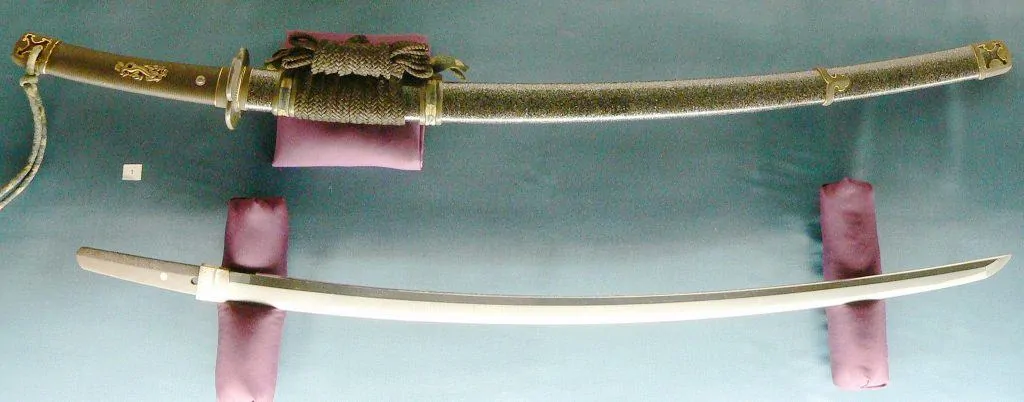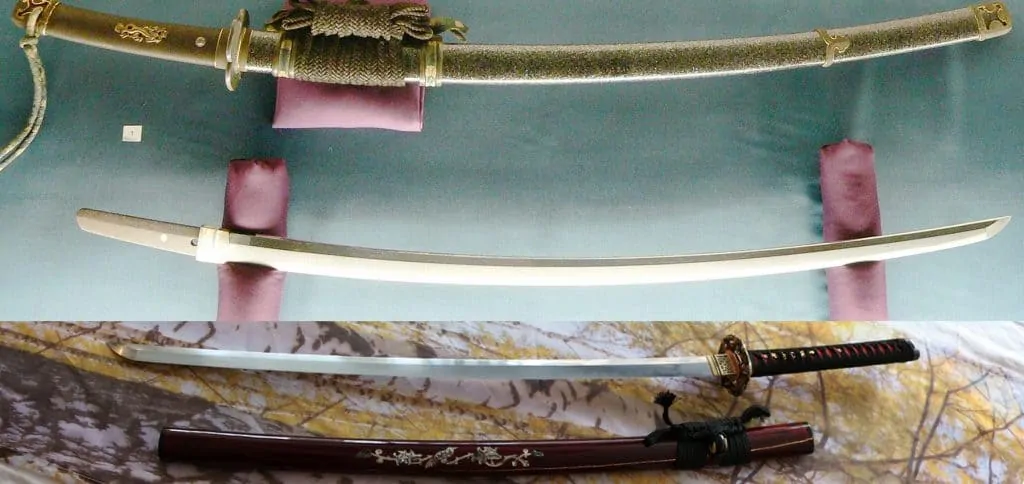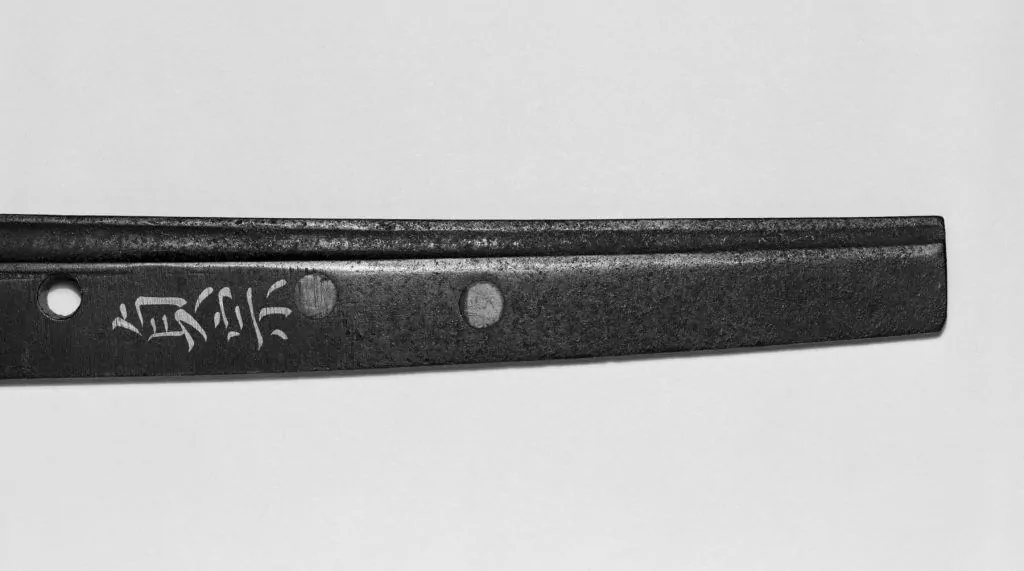
What is the difference between a katana and a tachi? I get asked this question a lot. Those two swords have a few key differences. I will now briefly cover those main distinctions.
The main difference is that the tachi has a longer blade and handle. Furthermore, the tachi is slightly more curved, worn edge facing down and was primarily used on horseback. Whereas the katana was used by foot soldiers and worn edge up.
These and more differences will now be covered in detail.
Table of Contents
Katanas were invented later
Let’s start with a short history lesson.
The tachi was invented a few centuries before the katana. According to historians, the tachi sword was first created 900 AD, whereas the katana came into being in the Kamakura Period (1192-1333 AD).
These approximately 300 years were enough to create two similarly looking, yet quite distinct swords. Therefore, we will now move on to the next interesting difference to answer the question tachi vs katana.
Tachi has a Longer Blade

The blade length is probably the easiest and most important aspect to tell whether a sword is a tachi or katana.
It took me a while to remember the approximate length of all the Japanese sword types, but believe me this is their most distinguishable feature.
The blade (nagasa) of a tachi is around 75 cm (29.5 in) long. On the other hand a katana has a blade length of around 70 cm (27.6 in).
This “tiny” difference might not seem to you like a lot, however in real combat this makes a difference.
A katana offers better maneuverability and can be used in houses (the length difference becomes more apparent when considering the handle – see next section).
However, even the katana is a rather long sword to be used inside buildings. Therefore, a shorter weapon like the wakizashi would be even better.
On the contrary, the tachi isn’t as effective in houses. Therefore, they were preferably used outdoors.
We are going to cover this aspect in more detail later on in this article.
Tachi has a Longer Handle

Besides the longer blade the tachi also features a longer handle (tsuka). It is no huge difference, as we see in the total length of both swords:
The katana has a length of around 100-110 cm (39.4-43.3 in), whereas the tachi is 120-130 cm (47.2-51.2 in) long. Both swords can be used with two hands.
So if you see a tachi and a katana the tachi is probably the longer one of the two. Keep in mind this also depends on the century the sword was crafted.
When comparing a 110 cm katana with a 120 cm tachi you would have to look very closely (as both could be katanas). But in case one sword is 30 cm longer it is easier to identify it as a tachi.
One more important thing to note is that there are way more Japanese swords types than you might think. Even I was quite surprised when I compiled a list in my Types of Japanese Swords Article.
For example a larger variant of the tachi is called nodachi. There are even smaller swords that look like a katana, the wakizashi for example.
I found out that the most distinguishable aspect of the Japanese swords is their size. (This works well in most cases, but knowing the other features increases accuracy)
Tachi has a more Pronounced Curve
One of the defining features of the katana is its curve. However, the curve on the katana is extremely slight. I consider the katana to be more similar to a straight sword than to a curved sword.
Even though the tachi is not as curved as a sabre it is quite a prominent feature. If you take a look at the pictures from the start again you see that the curve of the katana is a lot more shallow.
Contrarily the tachi has a more pronounced curve.
Katana is worn Edge Up

Another important difference to solve the question katana vs tachi is the way how they were worn.
Not only Japanese swords, but most swords, in general, were predominantly worn with the cutting edge facing down. This fact surely applies to the tachi, but not to the katana.
This is really a feature that makes that katana extremely special and unique. The katana was certainly worn with the edge facing upwards for a good reason.
Due to this alignment samurai gained a variety of combat advantages. It enabled the samurai to draw and cut in one motion. This art is also referred to as nukitsuke.
In a situation where fractions of a second could mean the difference between victory and defeat, the ability to draw and cut immediately is massively advantageous.
Different Usage
Another key difference that sets katana and tachi apart is the way they were used in battle.
As mentioned before the katana was used for fighting in close quarters. Most samurai used the katana as their main weapon (besides spears).
The katana offered foot soldiers the optimal balance between length and maneuverability. Furthermore, the katana could be used in nearly every fighting location. This made the katana a very good allrounder.
On the other hand, the tachi was a bit longer than the katana. Due to its length it couldn’t be used indoors as effectively.
However, the main difference is that the tachi was mainly used by cavalry units. The more pronounced curve of the sword, as well as the extended length, offered great benefits when fighting on horseback.
In contrast to the katana, the tachi wasn’t really good at stabbing. Whereas the katana excels at thrusting and cutting, the tachi was only suitable for slashing.
Swordsmith Signature

The last difference I want to point out is the signature of the swordsmith. Most Japanese Swords were signed on the tang by the swordsmith that forged the sword.
Do you remember that the katana was worn with its edge facing up? Due to this circumstance the name of the swordsmith would have to be written in reverse. Otherwise, you wouldn’t be able to properly read his name.
Unfortunately, not all swords were signed by their swordsmith. But if a Japanese sword is signed it is easy to tell if it is a katana or not.
Conclusion
Let’s sum up all the points we covered in this article. The easiest way to differentiate between a katana and a tachi is by their length. Generally speaking a tachi is longer than a katana.
Another key aspect is the more pronounced curvature of the tachi. Contrarily a katana has a way more shallow curve.
Even though not available on every Japanese sword the signature on the tang helps to tell whether a sword is a katana or not.
This is because the katana was worn edge facing upwards, therefore the signature was written in reverse.
However, it is important to keep in mind that there are dozens of different Japanese sword types. Differentiating between katana and tachi is relatively easy as we don’t regard all the other Japanese swords.
This is the moment when things start to get tricky and it becomes complicated to distinguish them.
As a rule of thumb I always tell people that the size is the most defining aspect of the swords. Even I don’t know the key defining features of all the 10+ Japanese Swords. (way too many to remember all of them :D )
By knowing their approximate size you can classify them correctly most of the time.
I hope you enjoyed this article. See you next time.